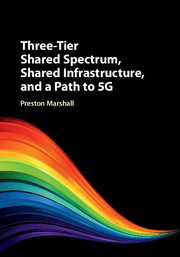
-
Select format
-
- Publisher:
- Cambridge University Press
- Publication date:
- 30 August 2017
- 03 August 2017
- ISBN:
- 9781108165020
- 9781107196964
- Dimensions:
- (247 x 174 mm)
- Weight & Pages:
- 0.83kg, 344 Pages
- Dimensions:
- Weight & Pages:
- Subjects:
- Engineering, Wireless Communications
You may already have access via personal or institutional login- Subjects:
- Engineering, Wireless Communications
Book description
Written by a leading expert in the field, this unique book describes the technical requirements for three-tier shared spectrum as well as key policy rationale and the impact for 5G. Detail is provided on the inception of the concept and its implementation in the US Citizens Broadband Radio Service (CBRS), along with descriptions of standards for deployment, algorithms required for implementation, and the broader consequences for wireless network and service architectures. The economic and innovation incentives offered by three-tier spectrum are described, along with potential outcomes such as widely deployed neutral host networks. There is also detailed technical analysis of the unique challenges introduced by three-tier spectrum, such as co-existence among non-cooperating networks. Covering a wide range of spectrum bands, International Telecommunication Union (ITU) international allocations, and rule structures that can be adapted for different regimes, this is ideal for an international readership of communications engineers, policy-makers, regulators, and industry strategic planners.
Contents
Metrics
Full text views
Full text views help Loading metrics...
Loading metrics...
* Views captured on Cambridge Core between #date#. This data will be updated every 24 hours.
Usage data cannot currently be displayed.
Accessibility standard: Unknown
Why this information is here
This section outlines the accessibility features of this content - including support for screen readers, full keyboard navigation and high-contrast display options. This may not be relevant for you.
Accessibility Information
Accessibility compliance for the PDF of this book is currently unknown and may be updated in the future.


